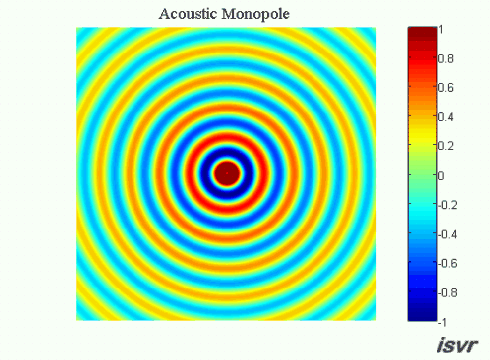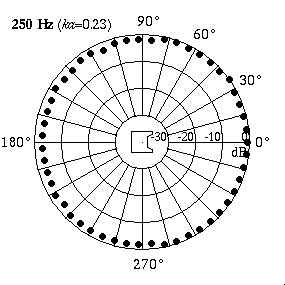Source Directionality and Echolocation Clicks.
In my last post, I mentioned in passing how the directionality of the source might cause problems for some conservation applications of passive acoustics. Shortly thereafter one of my highly intelligent yet non-acoustician friends said to me,
"Directionality? Who-the-what now?"
So, in this post I shall clarify.
But how to go about discussing directional sound without first discussing non-directional sound... hum....tricky.
I know YouTube!!
Here are two videos showing how sound propagates in a (pseudo) homogenous medium. First from a spherical source (bulb changing size) then from a more complicated source.
2-D pressure wave wave in a homogenous medium (kinda boring).
 |
| Link to gif source |
3-D pressure wave from a non-ideal source (awesome!!).
Things to notice about both of these.
- The sound wave radiates symmetrically form the source (point of very large volcano)
- The intensity of the sound is greater near the source. If you don't believe me I suggest standing next to an active volcano.
- It doesn't matter from what angle you are hearing the blast, so long as the distance is the same, the sound will be the same (assuming the world is ideal).
Got it? Good. Now, with echolocation clicks number 3 is not applicable. Mammals that use sound to "see" their environment would waste energy by producing sound waves with equal intensity in all directions. Instead, they point all the sound energy in front of them, the likely direction of travel. Like carrying a flashlight in the dark, to avoid smacking into a tree, it's generally advisable to point the flashlight ahead of you rather than behind.
How the sound propagates from echolocating animals, particularly dolphins, can be approximated by a piston in an infinitely rigid baffle.
Let me draw you a picture:
This is a piston, similar to what's in your car engine to make it move. However, instead of a chamber it's in an "infinitely rigid baffle" which is an erudite way to say a "wall" (physicists can be jerks like that). The term "baffle" means that the sound that is radiated can't pass behind the piston through the wall. Therefore, the sound can only propagate outward in a hemisphere in front of the piston. Similar to the volcano example where where the shock wave can propagate upwards and outwards but not downwards through the water (roughly, calm yourself nit-pickers).
This is not to be confused with:How the sound propagates from echolocating animals, particularly dolphins, can be approximated by a piston in an infinitely rigid baffle.
Again, a who's-in-a-what now?
Let me draw you a picture:
 |
| Piston (circular plate) moving in and out of an infinitely rigid baffle (wall). |
This is a piston, similar to what's in your car engine to make it move. However, instead of a chamber it's in an "infinitely rigid baffle" which is an erudite way to say a "wall" (physicists can be jerks like that). The term "baffle" means that the sound that is radiated can't pass behind the piston through the wall. Therefore, the sound can only propagate outward in a hemisphere in front of the piston. Similar to the volcano example where where the shock wave can propagate upwards and outwards but not downwards through the water (roughly, calm yourself nit-pickers).
 |
| Author's interpretation of things that may be confused with a piston. A.k.a an extreme attempt to avoid working on a literature review. |
So, as the piston moves in and out of the wall sound will be radiated as before. HOWEVER, the amplitude directly in front of the piston, called on-axis angle, will be much louder than the amplitude to the sides or the off axis angle.
 |
| Piston in a baffle (wall), sound in front of the piston is louder than to the sides |
Finally, we have a somewhat confusing image of the sound field that's generated by the piston in a baffle. Note, the sound still radiates out symmetrically (gray line), however the amplitude changes with the angle away from the center of the piston (off axis angle).
This is one adaptation bats and dolphins have evolved to optimize their effort when producing echolocation clicks. Using trained animals it's possible to make actual measurements of the sound field produced by the echolocation clicks. (Link to paper).
 |
| Jakobsen, Lasse, John M. Ratcliffe, and Annemarie Surlykke. "Convergent acoustic field of view in echolocating bats." Nature (2012). |
Now that we know how to approximate the sound field produced by an echolocating animal the next question is why is this exciting to a conservationist? Because conservation scientists are, as a general rule, broke! Therefore, when we do have the tools and expertise available to do animal surveys using acoustics (determining how many animals are in an area based on how many calls are recorded) it's very important to understand what the probability of detecting those calls is. If we can make a simple model of the sound then we can then produce estimates of how far away that sound might be heard, and as important how many animals we might be missing with our detection device.
So there you are! That is one reason why a conservation biologist might give a hoot about the math behind pistons in a baffle.
Thanks for reading, feel free to leave a comment below!
Oh yes! I almost forgot. Don't point that thing at me! Please.
Or, an overly dramatic video exploring one way humans have adapted directional sound to their own devices.
Additional Resources/Images and Movies
Unfortunately, I have no code for this post because the one Matlab example was taken directly from the k-wave tutorial files.
Dan Russell's Acoustic Animations website.
Great video by Oceans Initiative on echolocation of dolphins
Secret to a Sound Ocean from Oceans Initiative on Vimeo.
To learn more about this topic, check out:
http://www.oceansinitiative.org/acoustics/
To see the original research article:
http://onlinelibrary.wiley.com/doi/10.1111/acv.12076/abstract
Biological aspects of echolocation in dolphins.
Here is a very slow animation using k-wave of what that sound field would look like in the xy, yz and Z plane.


No comments:
Post a Comment
Comment forum rules.
1. Be accurate
2. Cite your sources
3. Be nice
Comments failing to meet these criteria will be removed